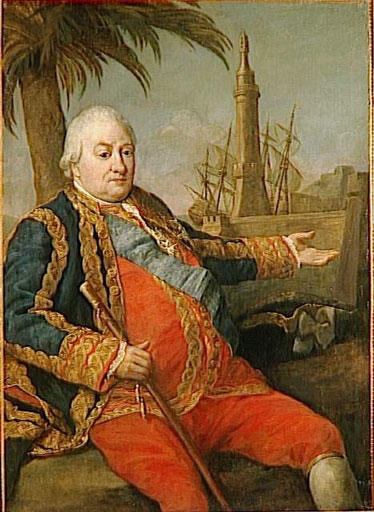 Admiral
comte Pierre André de Suffren de Saint Tropez, bailli de Suffren (17 July 1729
– 8 December 1788), French admiral. He was most famous for his campaign in the
Indian Ocean, in which he fought a series of intense and evenly matched
battles for supremacy against the established British power there, led by
Vice-Admiral Sir Edward Hughes. Alfred T. Mahan praised Suffren as "a very
great man" and evaluated him in terms he usually reserved for praising
decisively victorious admirals.[2]
Admiral
comte Pierre André de Suffren de Saint Tropez, bailli de Suffren (17 July 1729
– 8 December 1788), French admiral. He was most famous for his campaign in the
Indian Ocean, in which he fought a series of intense and evenly matched
battles for supremacy against the established British power there, led by
Vice-Admiral Sir Edward Hughes. Alfred T. Mahan praised Suffren as "a very
great man" and evaluated him in terms he usually reserved for praising
decisively victorious admirals.[2]
Pierre-André de Suffren de Saint Tropez has been called the greatest French
naval commander of the eighteenth century. In 1778 and 1779 he commanded part
of the squadron supporting the US patriots off the coast of North America and
in the West Indies. He led the line in the action with Admiral John Byron off
Grenada, and his ship, the Fantasque, lost sixty-two men.
In 1780 he
was captain of Zèle, in the combined French and Spanish fleets that captured a
great English convoy in the Atlantic. He sailed from Brest on March 22, 1781,
on the mission that was to put him in the first rank of sea commanders. On
April 16 he found the English expedition, under the command of Commodore
George Johnstone, at anchor in Porto Praya, Cape Verde Islands. Both squadrons
were en route to the Cape of Good Hope—the British to take it from the Dutch,
the French aiming to help defend it and French possessions in the Indian
Ocean. Suffren attacked at once, in what became known as the Battle of Porto
Praya. Some of the French ships weren’t ready for action, so Suffren had to
withdraw, but nevertheless it was a French victory, as Suffren was able to
beat Johnstone to the Cape and warn the Dutch before continuing to Mauritius.
Suffren was well known for the loving attention he gave to the sailors
under his command, including special provisions for food and medical care. His
men returned the affection. The Admiral was always surrounded by handsome
young sailors, known as “Suffren’s mignons.” He encouraged same-sex unions on
board his ships and enjoyed matching up older sailors with younger ones,
declaring that “men married to each other will behave the best in combat. They
will help each other. They are always in good spirits.” His ideas harkened
back to the Greek ideal of unit cohesion exemplified in the famous “Army of
Lovers” led by Epaminondas.
My published books:


BACK TO HOME PAGE

- Stern, Keith (2009-09-01). Queers in History: The Comprehensive
Encyclopedia of Historical Gays, Lesbians and Bisexuals (Kindle Locations
11431-11445). Perseus Books Group. Kindle Edition.
 Admiral
comte Pierre André de Suffren de Saint Tropez, bailli de Suffren (17 July 1729
– 8 December 1788), French admiral. He was most famous for his campaign in the
Indian Ocean, in which he fought a series of intense and evenly matched
battles for supremacy against the established British power there, led by
Vice-Admiral Sir Edward Hughes. Alfred T. Mahan praised Suffren as "a very
great man" and evaluated him in terms he usually reserved for praising
decisively victorious admirals.[2]
Admiral
comte Pierre André de Suffren de Saint Tropez, bailli de Suffren (17 July 1729
– 8 December 1788), French admiral. He was most famous for his campaign in the
Indian Ocean, in which he fought a series of intense and evenly matched
battles for supremacy against the established British power there, led by
Vice-Admiral Sir Edward Hughes. Alfred T. Mahan praised Suffren as "a very
great man" and evaluated him in terms he usually reserved for praising
decisively victorious admirals.[2]

